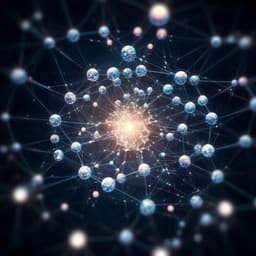
Physics
Genuine quantum networks with superposed tasks and addressing
J. Miguel-ramiro, A. Pirker, et al.
This groundbreaking research by J. Miguel-Ramiro, A. Pirker, and W. Dür delves into enhancing quantum networks with superposed tasks and addresses. By introducing a unique quantum control register, the authors unveil protocols that optimize quantum information handling and address devices in superposition, showcasing innovative advances in quantum forking and addressing procedures.
~3 min • Beginner • English
Introduction
The paper addresses how to elevate quantum networks from executing classically specified single tasks to genuinely quantum functionality where multiple network tasks and destinations are handled in coherent superposition. The context is that quantum networks, built either bottom-up (channel-based) or top-down (entanglement-based), currently perform tasks like teleportation or preparing a specific entangled state using classical control. The authors propose a framework where an external quantum control register encodes both which task(s) to perform and their superposition weights. The significance lies in enabling networks to create superpositions of target configurations (e.g., different entangled-state distributions), to send quantum information along superposed paths or to superposed recipients, and to perform operations like teleportation or graph-state manipulations coherently, potentially yielding improved robustness and new capabilities beyond classical mixtures of tasks.
Literature Review
The paper situates itself within quantum networking approaches (repeaters, bipartite vs multipartite entanglement-based networks) and stack models. It reviews prior work on routing in repeater networks and multipartite graph-state distribution, as well as fault tolerance and entanglement distillation to counteract noise. It connects to research on adding coherent control: universal programmable gate arrays are impossible in full generality (but approximate or finite-task versions are possible), superposed access to QRAM, superposition of processes and indefinite causal order, and results showing the impossibility of adding control to unknown operations. It references the quantum adder no-go results and probabilistic implementations when partial information is available. Compared to multipath routing or classical mixtures, the present work targets coherent superposition of tasks with externally provided quantum control, focusing on a finite set of known operations and known target states generated by controlled unitaries and measurements, adapted to communication scenarios.
Methodology
Core construction: A requester prepares a weight state on a single qudit that encodes the desired superposition weights over m tasks. Using a pre-shared (n+1)-qudit GHZ state among n devices and the initiator, a Bell measurement maps the weight state into a distributed request state so that each device holds exactly one control qudit. Each device is given a classical (or quantum program) description of which unitary U_i to apply for each control value i. Devices implement controlled unitaries C^i_j = (I − |i⟩⟨i|) ⊗ I + |i⟩⟨i| ⊗ U_i across local resource and auxiliary registers, synchronously across the network on the entanglement resource |ψ⟩_res and local auxiliary states |ψ⟩_aux. After these operations, all control qudits except the initiator’s are measured in a generalized Pauli X basis, leaving an entangled state between the initiator’s control and the processed resource+auxiliary systems. To obtain a target state without control, the constituents must be mutually orthogonal; otherwise, measuring the remaining control register may distort weights or introduce uncorrectable phases. The authors propose an extra-level trick: promote involved systems to higher-dimensional levels and apply control operations that map subspaces (e.g., {|0⟩,|1⟩} → {|2⟩,|3⟩}) to enforce orthogonality and enable deterministic control detachment with phase correction.
Fully quantum control/programming: The control can be fully quantum by appending a program register that encodes, per branch i, the set of local unitaries to be invoked via programmable gate arrays. For a finite set of tasks, deterministic programmable arrays are feasible; they yield residual program states R_i that must be tracked during processing.
Mimicking controlled classical tasks: The authors argue adding coherent control directly to classical tasks (e.g., measurement) is generally impossible due to nonlinearity and inconsistencies for mixed inputs. Instead, they mimic controlled measurements by always performing a measurement—but on either the desired system or a dummy/auxiliary system selected via a controlled-SWAP (Fredkin). By preparing the auxiliary in a state whose amplitudes match the measurement’s outcome probabilities on the target (or on the reduced state in an entangled setting), a subsequent measurement of the auxiliary yields a coherent superposition of “measured” and “unmeasured” branches with unchanged superposition weights. This generalizes to qudits and multi-outcome POVMs.
Protocols:
- Algorithm 1 (Controlled measurement): Prepare an auxiliary qubit/qudit whose basis expansion matches the target’s measurement probabilities; apply controlled-SWAP between target and auxiliary conditioned on the control; measure the auxiliary in the chosen basis; coherence is preserved and branches correspond to measurement outcomes.
- Algorithm 2 (Controlled teleportation): With an unknown input |ψ⟩ at A and a Bell pair between A and B, A uses two auxiliaries and two controlled-SWAPs, followed by a Bell measurement on auxiliaries. This yields a coherent superposition of “teleport” and “do not teleport,” with standard Pauli corrections applied conditionally. Because one branch measures part of a maximally entangled state, probability matching holds without knowledge of |ψ⟩.
- Algorithm 3 (Controlled cutting of graph states): For graph state |G⟩, node a prepares |+⟩_aux, performs controlled-SWAP between qubit a and aux, then measures aux in Z basis. This yields a superposition of the unaltered |G⟩ and the cut graph |G/a⟩, up to local Pauli Z corrections on neighbors.
- Algorithm 4 (Controlled merging of graph states): For |G1⟩ and |G2⟩, with qubits a1∈G1 and a2∈G2 at the same party, prepare |+⟩_aux, perform a controlled-SWAP between a2 and aux (with control inverted as needed), apply the merging measurement {P0,P1} on a1 and a2. The result is a superposition between unmerged (G1,G2) and merged (G1 ∪ G2), with local Pauli corrections if outcome 1 occurs.
Quantum-controlled addressing: Each device holds an addressing register a_d and an activation register a_c. A local generalized Toffoli-like comparator activates a device only if its a_d matches a_c, transferring control to a request register r_q and invoking the appropriate local operations via the program register. This supports selective, coherently controlled activation and remote invocation of unitary operations.
Resource/state toolbox: The work uses Bell states, GHZ states, and graph states; employs Bell measurements; shows LU-equivalence GHZ↔star-graph; gives graph cutting and merging rules; extends methods to qudits and multi-outcome measurements. The request/control distribution relies on a GHZ resource and Bell measurement to create distributed control registers.
Key Findings
- Genuine quantum functionality: Networks can coherently superpose multiple tasks and addressing choices using a distributed control (request) register constructed from a weight state and a shared GHZ state.
- No-go and workaround: Adding coherent control directly to classical tasks, especially measurements, is generally impossible due to nonlinearity; the authors provide a constructive workaround that mimics controlled classical tasks by always executing the task on either the real system or a dummy state selected via controlled-SWAP, preserving superposition weights.
- Concrete coherent protocols: Algorithms for controlled measurement, controlled teleportation (superposition of sending and not sending an unknown qubit), controlled cutting and merging of graph states are presented. They ensure amplitudes are preserved and corrections are local Pauli operations conditioned on measured outcomes.
- Control detachment: Detaching the control deterministically requires orthogonal constituents; an extra-level (qudit) mapping ensures orthogonality and enables phase correction, allowing preparation of superpositions without remaining control.
- Fully quantum programming: A program register with programmable gate arrays enables fully quantum specification of local operations per branch for a finite task set; residual program states must be tracked.
- Applications and advantages:
• Entanglement advantages vs classical mixtures: For superposed states like Σ_i |Φ_i⟩_12|Φ_i⟩_34/√2, the superposition is maximally entangled across all bipartitions, unlike the corresponding classical mixture (Smolin state) which is bound entangled; local phase corrections after control measurement yield the desired pure superposition.
• Entanglement/no-entanglement decision by control: Measuring the control in different bases can deterministically yield either an entangled Bell state or a separable product state between two parties.
• Robustness under losses: For the equal-weight superposition of all 3-party GHZ states among 4 parties (with orthogonality enforced), losing two systems leaves bipartite entanglement with negativity N = 0.1; the corresponding classical mixture becomes separable. For superpositions mixing GHZ and 1D cluster states, after detaching control and losing two systems, each branch retains higher negativity (N ≈ 0.35) than the mixture, which becomes separable.
• Superposed destinations: The same unknown state can be sent in a coherent superposition to different receivers; extra-level trick allows detaching control and correcting phases.
• Superposed paths: On a graph-state resource (e.g., 2D cluster), the link between two nodes can be established via a superposition of two different measurement paths, providing built-in robustness against node failures.
• Encoding/delocalization: Superpositions of codewords can be prepared, and an arbitrary qubit can be Bell-measured with the control to delocalize information across the network for protection and secret sharing.
- Generalization: Methods extend to qudits and multi-outcome POVMs; they also suggest potential benefits for superposed QEC and QKD protocols.
Discussion
The work demonstrates that by distributing quantum control and carefully structuring unitary-controlled operations with auxiliary systems, quantum networks can execute tasks in coherent superposition, addressing a gap where existing designs relied on classical control and single-task execution. The proposed constructions resolve the fundamental obstacle of coherently controlling classical operations by reframing tasks at the unitary level and always performing the classical action on either data or a dummy system. This enables coherent teleportation, graph-state manipulation, and addressing, with deterministic control detachment when orthogonality is enforced via extra levels. The applications indicate concrete advantages over classical mixtures and individual-task execution: stronger and more uniformly distributed entanglement, robustness against losses and path failures, deferred choice of entanglement structure, and flexible distribution/encoding of quantum information. These results suggest new design principles for network control planes that are themselves quantum, and motivate integrating such superposed-task capabilities into network stacks for enhanced performance and resilience.
Conclusion
The paper introduces a comprehensive framework to endow quantum networks with genuinely quantum functionality: handling superpositions of tasks and destinations via distributed quantum control, programmable local operations, and auxiliary-assisted controlled-SWAP techniques that mimic controlled classical tasks. It provides explicit protocols for coherent teleportation, controlled cutting and merging of graph states, and quantum-controlled addressing, as well as methods to detach control deterministically through orthogonality enforcement. Demonstrated applications show entanglement and robustness advantages compared to classical mixtures and single-task approaches, including superposed paths and destinations, and delocalized encoding. Future directions include formalizing controlled measurement limitations, extending the framework to broader classes of tasks (e.g., superposed QEC and QKD protocols), integrating fault-tolerance, exploring performance gains in distributed sensing where measurement on unknown states poses challenges, and experimental implementations on realistic network platforms.
Limitations
- Fundamental impossibility: Generally, one cannot add coherent control directly to classical tasks like measurements; the desired transformation is nonlinear and inconsistent for mixed inputs. The proposed schemes only mimic the effect by always performing the task on either the data or a dummy state.
- Knowledge requirements: Controlled measurement mimicking requires partial knowledge of the measurement basis and the target state’s (or reduced state’s) outcome probabilities to prepare the auxiliary appropriately; this is not directly applicable to metrology scenarios with unknown states.
- Control detachment constraints: Deterministic removal of the control register requires orthogonality among superposed constituents; otherwise measurements may modify weights or introduce uncorrectable phases. Extra-level (qudit) mappings are needed to enforce orthogonality, adding overhead.
- Programmable arrays: Fully quantum program registers with deterministic programmable gate arrays are feasible only for a finite set of tasks; residual program states R_i cannot generally be detached and must be accounted for.
- Resource overhead: Schemes require pre-shared GHZ states for control distribution, auxiliary systems, synchronized controlled-SWAPs, and measurements; when sending dummy states (e.g., over channels) resources are consumed even when no useful data is sent.
- Corrections and synchronization: Successful operation requires coordinated local corrections based on measurement outcomes across devices; synchronization is needed when preserving auxiliary entanglement or coordinated swaps in different branches.
Related Publications
Explore these studies to deepen your understanding of the subject.







